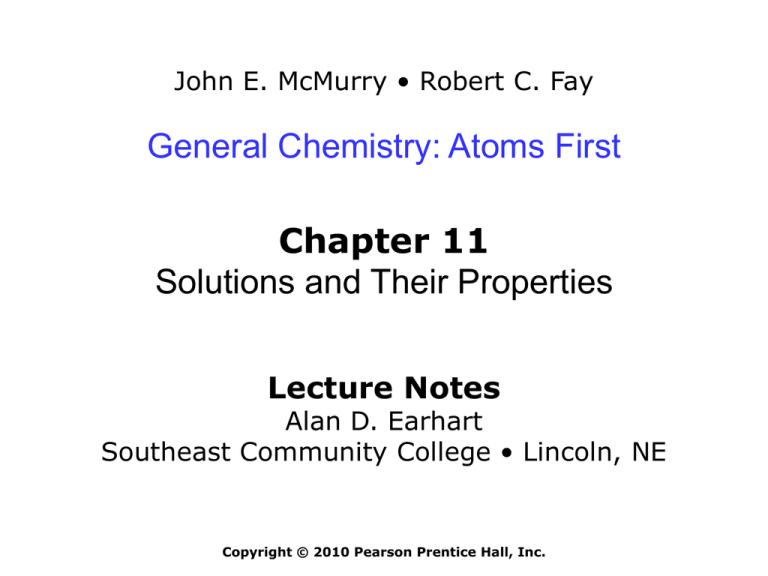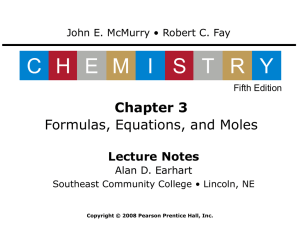
John E. McMurry • Robert C. Fay
General Chemistry: Atoms First
Chapter 11
Solutions and Their Properties
Lecture Notes
Alan D. Earhart
Southeast Community College • Lincoln, NE
Copyright © 2010 Pearson Prentice Hall, Inc.
Solutions
Solution: A homogeneous mixture.
Solvent: The major component.
Solute: A minor component.
Copyright © 2010 Pearson Prentice Hall, Inc.
Chapter 11/2
Solutions
Chapter 11/3
Energy Changes and the
Solution Process
Energy Changes and the
Solution Process
The sodium and chloride ions are hydrated.
Energy Changes and the
Solution Process
There is an entropy change for the solution process.
Energy Changes and the
Solution Process
There is an entropy change for the solution process.
Solution #1
Solution #2
Chapter 11/7
Energy Changes and the
Solution Process
∆G = ∆H - T∆S
endothermic: +∆H
exothermic: -∆H
spontaneous: -∆G
nonspontaneous: +∆G
Copyright © 2010 Pearson Prentice Hall, Inc.
Chapter 11/8
Energy Changes and the
Solution Process
Units of Concentration
Moles of solute
Molarity (M) =
Liters of solution
Moles of component
Mole Fraction (X) =
Total moles making up solution
Mass of component
Mass Percent =
x 100%
Total mass of solution
Moles of solute
Molality (m) =
Mass of solvent (kg)
Copyright © 2010 Pearson Prentice Hall, Inc.
Chapter 11/10
Units of Concentration
Assuming that seawater is an aqueous solution of NaCl,
what is its molarity? The density of seawater is 1.025 g/mL at
20 °C, and the NaCl concentration is 3.50 mass %.
Assuming 100.00 g of solution, calculate the volume:
100.00 g solution
1 mL
1L
x
x
= 0.09756 L
1.025 g
1000 mL
Convert the mass of NaCl to moles:
3.50 g NaCl
1 mol
x
58.4 g
= 0.0599 mol
Copyright © 2010 Pearson Prentice Hall, Inc.
Chapter 11/11
Units of Concentration
Then, calculate the molarity:
0.0599 mol
0.09756 L
= 0.614 M
Copyright © 2010 Pearson Prentice Hall, Inc.
Chapter 11/12
Units of Concentration
What is the molality of a solution prepared by dissolving
0.385 g of cholesterol, C27H46O, in 40.0 g chloroform, CHCl3?
Convert the mass of cholesterol to moles:
0.385 g
1 mol
x
= 0.000 997 mol
386.0 g
Calculate the mass of chloroform in kg:
40.0 g
1 kg
x
= 0.0400 kg
1000 g
Calculate the molality of the solution:
0.000 997 mol
= 0.0249 m
0.0400 kg
Copyright © 2010 Pearson Prentice Hall, Inc.
Chapter 11/13
Units of Concentration
Chapter 11/14
Some Factors Affecting
Solubility
Saturated Solution: A solution containing the
maximum possible amount of dissolved solute at
equilibrium.
dissolve
Solute + Solvent
Solution
crystallize
Supersaturated Solution: A solution containing a
greater-than-equilibrium amount of solute.
Copyright © 2010 Pearson Prentice Hall, Inc.
Chapter 11/15
Some Factors Affecting
Solubility
Chapter 11/17
Some Factors Affecting
Solubility
Some Factors Affecting
Solubility
Henry’s Law
Solubility = k P
Chapter 11/19
Physical Behavior of Solutions:
Colligative Properties
Colligative Properties: Properties that depend on the
amount of a dissolved solute but not on its chemical
identity.
•
•
•
•
Vapor-Pressure Lowering
Boiling-Point Elevation
Freezing-Point Depression
Osmotic Pressure
Copyright © 2010 Pearson Prentice Hall, Inc.
Chapter 11/20
Vapor-Pressure Lowering of
Solutions: Raoult’s Law
Raoult’s Law
Psoln = Psolv Xsolv
Vapor-Pressure Lowering of
Solutions: Raoult’s Law
The vapor pressure of pure water at 25 °C is 23.76 mm Hg.
What is the vapor pressure of a solution made from 1.00 mol
glucose in 15.0 mol of water at 25 °C? Glucose is a
nonvolatile solute.
Psoln = Psolv Xsolv
= 23.76 mm Hg x
15.0 mol
= 22.3 mm Hg
1.00 mol + 15.0 mol
Copyright © 2010 Pearson Prentice Hall, Inc.
Chapter 11/22
Vapor-Pressure Lowering of
Solutions: Raoult’s Law
Solutions of ionic substances often have a vapor pressure
significantly lower than predicted, because the ion-dipole
forces between the dissolved ions and polar water molecules
are so strong.
van’t Hoff Factor: i =
NaCl(aq)
moles of particles in solution
moles of solute dissolved
Na1+(aq) + Cl1-(aq)
For sodium chloride, the predicted value of i is 2. For a 0.05 m
solution of sodium chloride, the experimental value for i is 1.9.
Copyright © 2010 Pearson Prentice Hall, Inc.
Chapter 11/23
Chapter 11/24
Vapor-Pressure Lowering of
Solutions: Raoult’s Law
Ptotal = PA + PB = (P°A XA) + (P°B XB)
Boiling-Point Elevation and
Freezing-Point Depression
Chapter 11/26
Boiling-Point Elevation and
Freezing-Point Depression
Nonelectrolytes
Electrolytes
∆Tb = Kb m
∆Tb = Kb m i
∆Tf = Kf m
∆Tf = Kf m i
Chapter 11/28
Chapter 11/29
Boiling-Point Elevation and
Freezing-Point Depression
What is the freezing point (in °C) of a solution prepared by
dissolving 7.40 g of MgCl2 in 110 g of water? The van’t Hoff
factor for MgCl2 is i = 2.7.
Calculate the moles of MgCl2:
7.40 g
x
1 mol
= 0.0776 mol
95.3 g
Calculate the molality of the solution:
0.0776 mol
110 g
x
1000 g
1 kg
= 0.71
mol
kg
Copyright © 2010 Pearson Prentice Hall, Inc.
Chapter 11/30
Boiling-Point Elevation and
Freezing-Point Depression
Calculate the freezing point of the solution:
∆Tf = Kf m i = 1.86
°C kg
mol
x 0.71
mol
kg
x 2.7 = 3.6 °C
Tf = 0.0 °C - 3.6 °C = -3.6 °C
Copyright © 2010 Pearson Prentice Hall, Inc.
Chapter 11/31
Osmosis and Osmotic
Pressure
Osmosis: The passage of solvent through a semipermeable
membrane from the less concentrated side to the more
concentrated side.
Osmotic Pressure (): The amount of pressure necessary
to cause osmosis to stop.
Copyright © 2010 Pearson Prentice Hall, Inc.
Chapter 11/32
Chapter 11/33
= MRT
Chapter 11/34
Osmosis and Osmotic
Pressure
Calculate the osmotic pressure of a 1.00 M glucose
solution in water at 300 K.
= MRT = 1.00
mol
L
x 0.08206
L atm
x 300 K = 24.6 atm
K mol
Copyright © 2010 Pearson Prentice Hall, Inc.
Chapter 11/35
Some Uses of Colligative
Properties
Reverse Osmosis
Fractional Distillation of Liquid
Mixtures
Chapter 11/38









